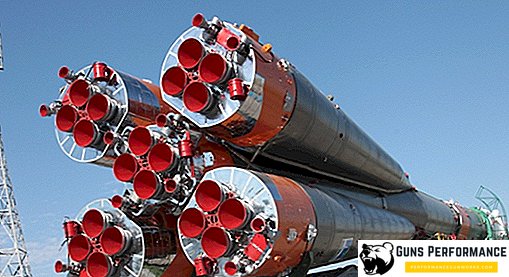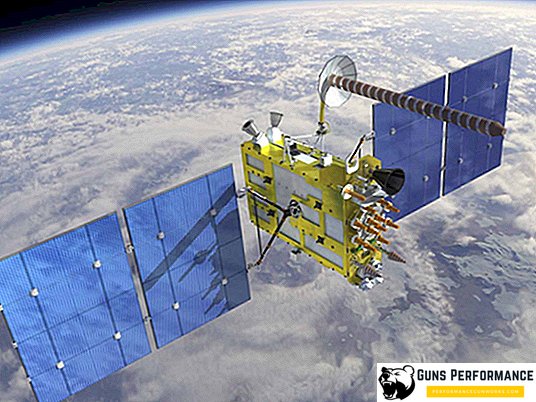
Flying into space is without doubt one of the most amazing achievements of our civilization. The famous Gagarin "go!" and Armstrong's first step on the lunar surface - historical milestones on the way to distant planets and other stellar systems. None of this would have been possible without the rocket engine, which allowed us to overcome the gravitational force of the planet and made it possible to go into near-earth orbit.
The device of the rocket engine, on the one hand, is so straightforward that you can build it at home by yourself, spending literally three kopecks on it. But, on the other hand, the design of space and military rockets is so complex that only a few states in the world have their manufacturing technology.
A rocket engine (RD) is a type of jet engine, the working body and energy source of which is directly on board the aircraft. This is its main difference from jet engines. Thus, the taxiway does not depend on the oxygen of the atmosphere and therefore can be used for flights in space (airless) space.
Russia is one of the world leaders in the field of rocket engine building. The backlog inherited from the Soviet Union is impressive. Domestic industry is able to produce the best rocket engines of various purposes. Proof of this is the RD-180 rocket engine, which is used in the American Atlas. Deliveries to the United States began in 2000 and continue to this day. There are other interesting developments, and we are talking not only about powerful engines for space or ballistic missiles, but also taxiways for various weapon systems.
Currently, the most common so-called chemical rocket engines, in which the specific impulse is formed due to the combustion of fuel. In addition to these, there are also nuclear and electric engines. In this article we will talk about how the rocket engine works, tell about its advantages and disadvantages, and also present the current classification of taxiways.
Some physics or how it works
Different types of rocket engines have significant differences in their design, but the work of any of them is based on Newton's famous third law, which says that "every action has equal resistance." The RD emits a jet of working fluid in one direction, and itself, in accordance with the Newtonian postulate, moves in the opposite direction. The products of fuel combustion go through the nozzle, forming cravings - these are the basics of the theory of rocket engines.
If you are standing in the boat, throw a stone from the stern, then your ship will sail a little ahead. This is the visual model of the functioning of all rocket engines. Another example would be the work of a fire hose, from which water is ejected under high pressure. To hold it you need to make some effort. If you put a fireman on a skateboard and give him a hose, he will move at a fairly high speed.
The main characteristic that determines the effectiveness of such systems is thrust (thrust force). It is formed as a result of the transformation of the initial energy into the kinetic jet of the working fluid. In the metric system, rocket engine thrust is measured in newtons, while Americans count it in pounds.

Another important parameter of rocket engines is the specific impulse. This is the ratio of the thrust force (or amount of movement) to the fuel consumption per unit of time. This parameter is considered as the degree of perfection of a particular taxiway, and is a measure of its efficiency.
Chemical engines operate due to the exothermic reaction of combustion of fuel and oxidant. This type of RD has two components:
- A nozzle in which thermal energy is converted to kinetic;
- The combustion chamber, where the combustion process takes place, that is, the conversion of chemical energy of fuel into heat.
From the history of this issue
The rocket engine is one of the oldest engine types known to mankind. We cannot precisely answer the question when exactly the first rocket was made. There is an assumption that this was done by the ancient Greeks (the wooden pigeon of the Archite of Tarent), but most historians consider China to be the birthplace of this invention. This happened around the 3rd century AD, shortly after the discovery of gunpowder. Originally, rockets were used for fireworks and other entertainment. Powder rocket engine was quite effective and easy to manufacture.
It is believed that these technologies came to Europe somewhere in the XIII century, they studied the English naturalist Roger Bacon.
The first combat missile was developed in 1556 by Konrad Haas, who invented various types of weapons for Emperor Ferdinand I. This inventor can be called the first creator of the theory of rocket engines, he also authored the idea of a multi-stage rocket - the mechanism of operation of an aircraft consisting of from two rockets. The survey was continued by a Pole, Kazimir Semenovich, who lived in the middle of the 17th century. However, all these projects remained on paper.
The practical use of missiles began only in the XIX century. In 1805, British officer William Congreve showed powder rockets, which had unprecedented power at that time. The presentation was impressed, and the Congreve’s missiles were adopted by the British Army. Their main advantage, compared with the barrel artillery, was high mobility and relatively low cost, and the main drawback was the accuracy of the fire, which left much to be desired. By the end of the 19th century, rifled guns were widely spread; they fired very accurately, so the missiles were removed from service.

In Russia, this issue was handled by General Zasyadko. He not only improved the Congrive missiles, but also the first to propose using them for a flight into space. In 1881, the Russian inventor Kibalchich created his own theory of rocket engines.
Another our compatriot, Konstantin Tsiolkovsky, made a huge contribution to the development of this technology. Among his ideas is the liquid rocket engine (LRE), working on a mixture of oxygen and hydrogen.
At the beginning of the last century, enthusiasts in many countries of the world were engaged in the creation of a liquid RD, the first to succeed was American inventor Robert Goddard. His rocket, working on a mixture of gasoline and liquid oxygen, was successfully launched in 1926.
The Second World War was a period of the return of rocket weapons. In 1941, the installation of the BM-13 volley fire, the famous Katyusha, was adopted by the Red Army, and in 1943 the Germans began using the ballistic V-2 with a liquid-propellant rocket engine. It was developed under the direction of Werner von Braun, who later headed the American space program. Germany also mastered the production of the KR V-1 with a direct-flow jet engine.

After the end of the war between the USSR and the USA, a real “rocket” race began. The Soviet program was headed by Sergey Korolev, an outstanding designer of rocket engines, it was under his leadership that the domestic ICBM R-7 was created, and later the first artificial satellite was launched and a manned space flight was carried out.
Over the years, attempts have been made to create rocket engines operating at the expense of the energy of nuclear decay (synthesis), but it never came to practical use of such power plants. In the 70s, the use of electric rocket engines began in the USSR and the USA. Today they are used to correct the orbits and course of spacecraft. In the 70s and 80s there were experiments with plasma XRDs, which are believed to have good potential. High hopes are attributed to ion rocket engines, the use of which theoretically could significantly speed up spacecraft.
However, so far almost all these technologies are in their infancy, and the main vehicle of the space explorers remains the good old "chemical" rocket. Currently, the American F-1, which participated in the lunar project, and the Soviet RD-170/171, which was used in the program "Energy-Buran", are competing for the title of "the most powerful rocket engine in the world".
What are they like?
The classification of rocket engines is based on the method of obtaining energy for rejecting the working fluid. Based on this parameter, taxiways are:
- chemical;
- nuclear (thermonuclear);
- electric (electric rocket);
- gas.
Each of the above types can be divided into smaller categories. Chemical engines (HDR), for example, depending on the state of aggregation of the fuel, are solid-fuel and liquid-fuel. There is also a chemical hybrid rocket engine (GRD). The HDR also includes a wedge air rocket engine, which has a different shape and nozzle design. There are gas-phase and solid-phase nuclear RD. There are several types of electrical power plants.
Chemical RD: advantages and disadvantages
This type of rocket engine is the most common and well mastered. We can say that it was HRD that gave space to humanity. It works due to an exothermic chemical reaction, and both the fuel and the oxidizer are on board the aircraft and together form the fuel. It also serves as a source of energy, and the basis for the working fluid.
HDDs have a relatively small specific impulse (when compared with electrical ones), but they allow them to develop greater traction. This is especially important for launching rocket engines and when removing payloads into orbit.
In liquid engines, the oxidizer and fuel are in the liquid phase. With the help of the fuel system, they are fed into the chamber, where they are burned and flowing through the nozzle.

In a solid fuel RD, a mixture of fuel and oxidizer is placed directly in the combustion chamber. As a rule, the fuel has the shape of a rod with a central channel. The combustion process goes from the center to the periphery, the gases, coming out through the nozzle, form a thrust. These engines have several advantages: they are relatively simple, cheap, environmentally friendly and reliable.
The disadvantages of a solid-propellant chemical engine include the limited duration of its operation, a small indicator of the specific impulse (compared to liquid XRDs) and the impossibility of restarting - after starting it can no longer be stopped. The above features determine the scope of use of solid propellant taxiways - these are ballistic and meteorological rockets, missiles, missiles, missiles, rocket projectiles for volley fire systems. Solid fuels are also used in starting rocket engines.
Liquid taxiways have a higher specific impulse, they can be stopped and restarted again, and thrust - to regulate. In addition, compared with solid fuel, they are lighter and more compact. But there is also a fly in the ointment: fluid engines have a complex structure and high cost, so the main area of their use is astronautics.
As components of fuel for liquid XRD use various combinations. For example, oxygen + hydrogen or nitrogen tetraoxide + asymmetric dimethyl hydrazine. In recent years, oxygen and kerosene rockets have become very popular. Fuel may consist of five or more parts. Methane rocket engines are considered to be very promising; today they are engaged in their creation in several countries of the world. Among other interesting developments in this area, we can mention the so-called detonation rocket engine, whose fuel does not burn, but explodes.

Work on improving the HDR does not stop, but it is likely that its limits have already been reached - the designers have “squeezed” everything they could from the chemical fuel. A serious problem of the HDR is the huge mass of fuel that the aircraft must lift. And this is wildly ineffective. The scheme with detachable steps somewhat improved the situation, but clearly did not become a panacea.
It should be noted that chemical rocket engines are used not only for space exploration. They found their use on Earth, though, basically only in military affairs. All combat missiles, starting with small aircraft or anti-tank, and ending with huge ICBMs, are equipped with HRA. Overwhelmingly, they have simpler and more reliable solid fuel engines. An example of the peaceful use of HRD are geophysical and meteorological rockets.
On the atomic ship to the stars!
Liquid rocket engine gave man space and helped to get to the nearest planets. The speed of jet jet exhaust on liquid fuel does not exceed 4.5-5 m / s, which makes it unsuitable for distant missions - this requires tens of meters per second. Spacecraft with HRDs are still able to deliver a person to the nearest planets - like Mars or Venus - but to travel to distant objects of the Solar System we will have to come up with something new. One of the ways out of this impasse seems to be the use of energy hidden in the atomic nucleus.
A nuclear rocket engine (YARD) is a type of power plant in which the working fluid is heated by nuclear fission or synthesis energy. Depending on the state of the fuel, it can be solid, liquid or gas phase. Hydrogen or ammonia is commonly used as the working medium. Traction YARD is quite comparable with chemical engines, while they have a high specific impulse. But there is one problem - the pollution of the atmosphere by radioactive exhaust.

The history of nuclear engines began in the mid-50s, two countries in the world — the United States and the Soviet Union — were engaged in their practical creation. Already in 1958, the Americans set the task of creating a YARD for flights to the Moon and Mars (the NERVA program). Around the same time, Soviet designers also dealt with similar issues. By the end of the 70s, the RD-0410 nuclear rocket engine was created, but it did not pass full tests.
Currently, the most promising are gas-phase nuclear engines, in which the fuel is in a gaseous state in a special sealed flask. This eliminates its contact with the working fluid and significantly reduces the likelihood of radioactive contamination. Despite the fact that the main technical problems of creating NREs have long been resolved, so far none of them have found their application in practice. Although, this particular YARD looks the most promising from the point of view of real use.
Electric rocket engines, their features, advantages and disadvantages
Another possible competitor, which has a chance to replace the HRD, is an electric rocket engine (ERE), which uses electrical energy to disperse the working fluid.

The idea of creating such a power plant was born at the beginning of the 20th century; in the 1930s, Soviet scientist Glushko implemented it in practice. Active work on electric propulsion began in the United States and the USSR in the 1960s, and in the 1970s, the first rocket engines of this type were already installed on spacecraft.
There are several types of ERDs:
- electrothermal;
- electrostatic;
- electromagnetic;
- plasma
Electric rocket engines have a high specific impulse rate, which allows them to economically consume the working fluid, but they also need a lot of energy, which is a serious problem. So far, the only real source for electric propulsion is solar panels. They have low thrust, which does not allow them to be used within the limits of the earth's atmosphere - the launch rocket engine from the propulsion engine will definitely not work. Currently they are used as shunting - for the correction of the orbits of spacecraft.












